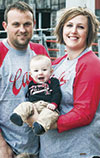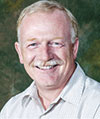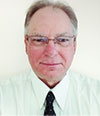World Dairy Expo features the best and the brightest during its world-class seminars.
This year’s expo seminars include topics on robotic milking systems, A2 milk, transition cow health, mycotoxin in feedstuffs, consumer perceptions, cover crops and future farm labor.
Continuing education credits can be earned by members of the American Registry of Professional Animal Scientists (ARPAS) and the American Association of State Veterinary Boards – RACE Program (RACE). All seminars will be archived for viewing online.
Seminars will be showcased Tuesday through Saturday in the Mendota 2 meeting room, located in the Exhibition Hall. Expo seminar sponsors are: Compeer Financial, Quality Liquid Feeds Inc., Phibro Animal Health Corp. and Feed Supervisor Software.
Following is a brief synopsis of each seminar.
Tuesday, Oct. 3, 1 p.m.
 “Building a Stronger Relationship between Dairy Owner and Dairy Banker”
“Building a Stronger Relationship between Dairy Owner and Dairy Banker”
Arthur Moessner, vice president – dairy team lead, American AgCredit
Sponsored by: Compeer Financial
Continuing Education Credits: ARPAS (1), RACE (1)
Dairy owners require a stable and reliable source of borrowed capital from dairy bankers to maintain and grow their operations. Dairy bankers rely on dairy owners to operate profitably and make good business decisions to repay loans.
The relationship between owner and banker can be complex but is necessary for dairy success. Arthur Moessner, vice president, dairy team lead, American AgCredit, will examine the owner/banker relationship, propose ways to elevate relationships to the next level and discuss why investing time and energy into relationships can add to the profitability of a dairy.
He will share ideas to strengthen the owner/banker relationship in a volatile dairy industry and changing lending environment. Moessner has financed dairy operations in the West, Southwest and Midwest areas of the U.S. for three decades with commercial banks and the farm credit system.
Wednesday, Oct. 4, 11 a.m.

“Economics of Robotic Milking Systems”
Larry Tranel, dairy specialist, Iowa State University Extension and Outreach
Lance and Joanne Schutte, owners, Jo-Lane Dairy; Doug Gernes, owner, Gernes Dairy LLC
Sponsored by: Quality Liquid Feeds Inc.
Continuing Education Credits:
ARPAS (1), RACE (1)
Robotic milking systems continue to gain in popularity for milking and managing dairy herds. Producers considering these systems are trying to balance two big factors: labor issues and investment costs.
This seminar will highlight these factors and other variables through the use of a partial budget analysis to help determine if positive profits and cash flow are possible with robots. Larry Tranel will lead the presentation and include Lance and Jonna Schutte and Doug Gernes, producers using robotic milking systems.
Tranel has spent nearly three decades with extension, first in Iowa County, Wisconsin, as a dairy/farm management agent, followed by 18 years as the dairy field specialist for Iowa State University Extension and Outreach.
Throughout his career, Tranel has authored the “Millionaire Model Dairy Farm” project and the “Managing Dairy Farm Finances” program, among others. As a leading researcher, he recently presented his information on economic variables of robotic milking systems at the USDA’s 2017 World Ag Outlook Forum in Washington, D.C.

Lance and Jonna Schutte own and operate Jo-Lane Dairy in Monona, Iowa, with their four young children. Jo-Lane Dairy utilizes Lely Astronaut A4 robotic units to milk its herd of 140 Holstein and Brown Swiss cows.
Prior to the installation of the robots in 2013, the Schuttes were milking in a tiestall barn while housing cattle in a freestall facility.
Beyond the milking herd, the family raises 150 replacement heifers and a handful of breeding bulls, along with corn and alfalfa.
 Doug Gernes is the third generation to own and operate Gernes Dairy LLC in Winona, Minnesota. In 2016, Gernes transitioned his 240-cow herd from a double-12 parlor to four DeLaval VMS units.
Doug Gernes is the third generation to own and operate Gernes Dairy LLC in Winona, Minnesota. In 2016, Gernes transitioned his 240-cow herd from a double-12 parlor to four DeLaval VMS units.
This adjustment in management has increased milk production from 79 pounds of milk per day to 90 pounds of milk per day in the first year, while simultaneously decreasing somatic cell counts.
In addition to the milking herd, Gernes manages 800 acres of alfalfa, corn and soybeans.
Wednesday, Oct. 4, 1 p.m.
 “Making Sense of Dairy and Anti-Inflammation: Yogurt, Obesity and A2 Milk”
“Making Sense of Dairy and Anti-Inflammation: Yogurt, Obesity and A2 Milk”
Bradley Bolling, assistant professor,
Department of Food Science,
University of Wisconsin – Madison
Continuing Education Credits: ARPAS (1), RACE (1)
Dairy consumption may benefit the immune system by having an anti-inflammatory effect. The composition of milk and processing may affect anti-inflammatory activity of dairy products. A2 milk is gaining recognition in the U.S. dairy industry, in part because of its health claims.
More producers are choosing to breed cattle to express the A2 gene and supply an emerging specialty market. Bradley Bolling will lead a discussion on the complex demand of A2 milk, and the claims and evidence for its beneficial effects on the human body.
Bolling, an assistant professor in the food science department at the University of Wisconsin – Madison, concentrates his research on food chemistry and nutrition. He leads research on dietary components that can reduce the risk of chronic diseases, focusing on antioxidant and anti-inflammatory efforts.
In this seminar, Bolling will discuss a link between yogurt, gut health and its benefits. He will also outline the connection between inflammation and chronic diseases, and claims of how A1 and A2 milk can improve health.
Thursday, Oct. 5, 11 a.m.
 “Health and Immunity in Transition Cows”
“Health and Immunity in Transition Cows”
Marcus Kehrli, director, National Animal Disease Center – USDA-ARS
Sponsored by: Phibro Animal Health Corp.
Continuing Education Credits: ARPAS (1), RACE (1)
The transition period for dairy cows is a critical time. While dealing with immune suppression, cows are at a high risk for developing the two most costly diseases impacting longevity and profitability: mastitis and metritis.
Marcus Kehrli will present research on immune suppression and changes for a transition dairy cow. He will also highlight methods to restore a cow’s immune capacity, thus reducing mastitis incidence and severity. This research is part of an ongoing study at the USDA’s National Animal Disease Center in Ames, Iowa, where Kehrli serves as director.
For more than 35 years, Kehrli has worked with infectious and emerging disease research. In addition to his current work on immune suppression in transition cows, he is credited for the discovery of bovine leukocyte adhesion deficiency (BLAD) and the development of the diagnostic test to genotype cattle for BLAD, leading to the elimination of this recessive lethal genetic disease in dairy cattle.
Thursday, Oct. 5, 1 p.m.
 “Limiting Mold and Mycotoxin Problems in Dairy Herds”
“Limiting Mold and Mycotoxin Problems in Dairy Herds”
Lon Whitlow, professor emeritus,
North Carolina State University
Sponsored by: Feed Supervisor Software
Continuing Education Credits: ARPAS (1), RACE (1)
Mycotoxin and molds in forages wreak havoc on a dairy cow’s production and health. To address these issues, the key is understanding the occurrences, effects and prevention efforts.
Lon Whitlow will focus on the impacts mycotoxins have on the digestive system and immunity of dairy cattle. He will also cover relevant information regarding feed handling, specifically for silage, and prevention and treatment methods of molds and mycotoxins.
Whitlow is professor emeritus of dairy nutrition at North Carolina State University. His extension work and research is on applied nutrition and mycotoxin issues. Through his research, Whitlow has discovered mycotoxins routinely occur in a variety of feedstuffs, and that specific feed additives and management practices are effective in reducing mycotoxin toxicity and milk residues.
Friday, Oct. 6, 11 a.m.
“Consumer and Public Perceptions of the U.S. Dairy Industry: Implications for Practices, Policy and Market Demand”
Christopher Wolf, professor,
Michigan State University
Continuing Education Credits: ARPAS (1), RACE (1)
Increasing public scrutiny of production practices in agriculture has significant implications for dairy producers. This creates a need to understand public attitudes and perceptions. Decisions farmers make about production practices have the potential to impact public trust and their social right to farm.
This presentation, led by Christopher Wolf, will assess these perceptions of the public and issues relating to dairy cattle welfare, allowing for discussion and monitoring. He will also discuss the economic impacts public opinions can have on dairy farm profitability. Wolf is a professor of agricultural, food and resource economics at Michigan State University, where he has worked for the past two decades.
His primary focus is the effect of public policy on farm behavior and financial outcome, aiming to focus on issues of current and future importance to policy-makers and industry decision-makers.
Friday, Oct. 6, 1 p.m.
 “Cover Crop Management for Dairy Producers”
“Cover Crop Management for Dairy Producers”
Karla Hernandez, forages field specialist,
South Dakota State University Extension
Continuing Education Credits: ARPAS (1), RACE (1)
For years, cover crops have been used as a conservation tool. They help to eliminate erosion, increase soil fertility – and now they have a role in dairy farming too. Karla Hernandez will discuss the use of cover crops as a supplemental forage in grazing operations and how they can extend the grazing season.
She will also address how cover crops affect soil nutrients as producers look for ways to increase soil health. As the forages field specialist for South Dakota State University, Hernandez works with many livestock producers and will spend time discussing rotations and over-wintering species.
In her position, Hernandez works to develop research-based programming and support for South Dakota’s growing number of forage producers, in addition to managing alfalfa variety research plots.
Saturday, Oct. 7, 11 a.m.
 “Who Will Work on America’s Farms in 2025?”
“Who Will Work on America’s Farms in 2025?”
Don Albrecht, director,
Western Rural Development Center
Continuing Education Credits: ARPAS (1), RACE (1)
Advancements in technology have led to a decline in the number of farmworkers. At one point, agriculture was the largest economic segment of the U.S. population. As farmworker numbers continue to decline, rural towns, especially farm-dependent communities, feel the effects.
This leaves many to wonder: Who will work on America’s farms in 2025? Don Albrecht deals with challenges facing rural America, including the changing characteristics of farmworkers, in his position as the director for the Western Rural Development Center.
Albrecht spent 27 years at Texas A&M University and has authored five books and numerous articles on rural America. ![]()



